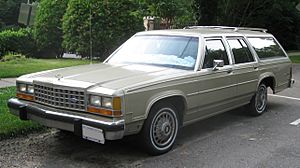Station wagon facts for kids
A station wagon is a type of car that looks a bit like a sedan (a regular car with a separate trunk) but has some big differences. Instead of a separate trunk, the roof of a station wagon extends all the way to the back. This creates one large space for both passengers and cargo. Imagine a car where the back seats and the storage area are all connected! This design makes station wagons very practical for families or anyone who needs to carry a lot of stuff.
Over time, station wagons became less common as other types of vehicles grew in popularity. They were largely replaced by minivans, which offered even more space, and later by crossovers, which combine features of cars and SUVs.
Contents
What is a Station Wagon?
A station wagon is a car body style that combines the front part of a sedan with an extended roofline. This roof goes all the way to the back of the car. It also has a rear door, often called a liftgate, for easy access to the cargo area. This design makes the inside of the car very flexible. You can carry more passengers or fold down the back seats to create a huge space for luggage, sports gear, or even pets.
How Station Wagons Are Different
The main difference between a station wagon and a sedan is how their back ends are designed.
- A sedan has a separate trunk that is usually sealed off from the passenger area.
- A station wagon has an open cargo area that is part of the passenger cabin. This means you can reach items in the back from the front seats. This design is often called a "two-box" design, where the engine is one box and the passenger/cargo area is the second. Sedans are "three-box" designs, with the engine, passenger, and trunk areas all separate.
Why People Liked Station Wagons
Station wagons were very popular for many years, especially with families. They offered a great mix of comfort and utility.
- Space: They had plenty of room for several passengers and all their belongings. This was perfect for road trips or daily errands.
- Versatility: The large cargo area meant you could easily transport large items that wouldn't fit in a regular car. Think of bicycles, camping gear, or even small furniture.
- Driving Feel: Unlike larger vans or SUVs, station wagons often drove more like regular cars. They were easier to park and handle.
History of Station Wagons
Station wagons have a long and interesting history, changing a lot over the years.
Early Days: Wooden Wagons
The very first station wagons appeared in the early 1900s. They were often called "depot hacks" or "station hacks." These early vehicles were built on car chassis but had custom wooden bodies. They were used by hotels and train stations to carry passengers and their luggage. The name "station wagon" comes from their use at train stations.
Growth in Popularity: 1950s to 1970s
After World War II, station wagons became very popular family cars. Car manufacturers started building them directly in their factories, making them more affordable.
- In the 1950s, they often featured "woodie" styling, with wood panels on the sides. These were very stylish at the time.
- By the 1960s and 1970s, station wagons were a common sight on American roads. They were seen as the ideal family vehicle, perfect for suburban life and cross-country vacations. Many models even offered a third row of seats, facing backward, for extra passengers.
Decline and Modern Wagons
By the 1980s and 1990s, the popularity of station wagons began to decline.
- Minivans: The introduction of minivans like the Chrysler Voyager in the 1980s offered even more passenger and cargo space, often with sliding doors that were convenient for families.
- SUVs and Crossovers: Later, SUVs (Sport Utility Vehicles) and crossovers became very popular. These vehicles offered a higher driving position, rugged looks, and often four-wheel drive, appealing to many buyers.
Today, station wagons are still made, but they are less common in some regions, like North America. However, they remain popular in Europe, where they are known for their practicality and fuel efficiency. Modern station wagons often have sleek designs and advanced technology, appealing to people who want a versatile car that drives well.
Images for kids
-
A lift-gate on a Volkswagen Passat Variant
See also
 In Spanish: Familiar (automóvil) para niños
In Spanish: Familiar (automóvil) para niños











